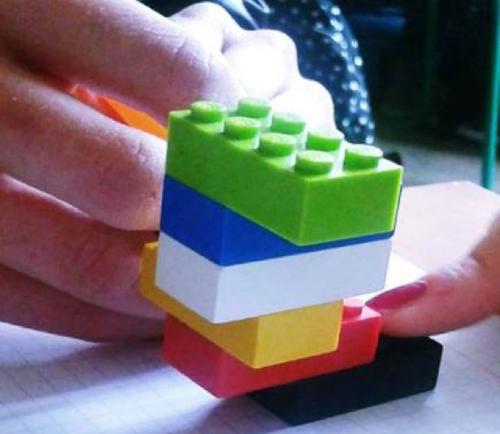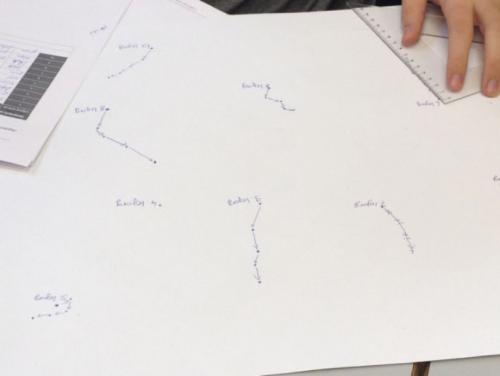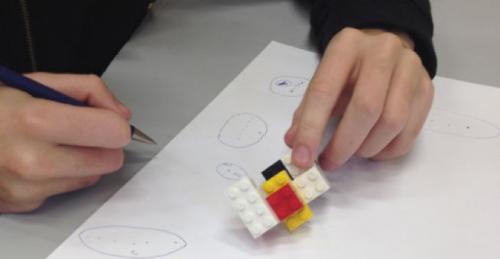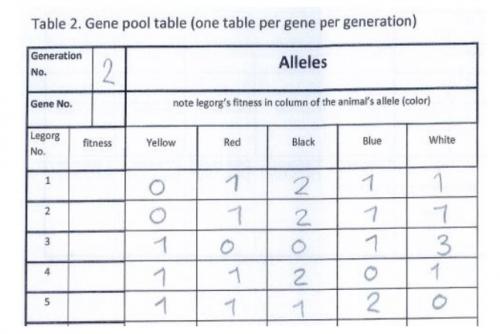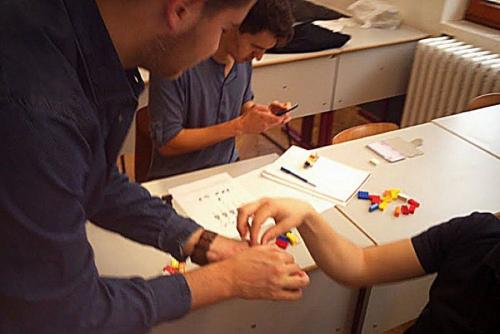The Natural selection SAILS inquiry and assessment unit focuses on natural selection and the Darwinian theory of evolution, which is part of the biology curriculum at upper second level in most European countries. The topic is addressed in a structured, hands-on activity, during which students simulate a gene pool and the random selection of alleles. They assemble model organisms, called Legorgs, out of Lego® bricks, and measure their fitness. They use this physical simulation to grasp the underpinning concepts of adaptation by natural selection.
The skills developed in this unit include planning investigations, forming coherent arguments and working collaboratively. Skills in scientific reasoning, such as collecting data, drawing conclusions are enhanced and students' scientific literacy is enriched through comparisons between the physical simulation and the real world. This activity is recommended for implementation at upper second level, where students have sufficient mathematical knowledge to numerically analyse a large quantity of data, and have conceptual understanding of the biology involved. The assessment methods described in the unit include teacher observation, use of student artefacts and classroom dialogue.
This unit was trialled by teachers in Poland, Hungary, Denmark and Sweden – producing five case studies. In all cases, the teaching approach was guided inquiry, although teachers also allowed open inquiry where feasible. Students were aged 14-19 years, with those in Poland and Sweden at lower second level. Skills assessed included planning investigations, working collaboratively, scientific reasoning and scientific literacy.
- Visualising evolution: gaining a deeper understanding of the biology and random nature involved
- Natural selection
- Genetic drift
- Fitness
- Lower
- Upper
- Planning investigations
- Forming coherent arguments
- Working collaboratively
- Scientific reasoning
- Scientific literacy
- Classroom dialogue
- Teacher observation
- Worksheets
- Student devised materials
- Other assessment items
The Natural selection SAILS unit details a hands-on exercise on natural selection, designed for students aged 15-18 years, in which they investigate multiple genes in LEGO animals (Legorgs). The teaching and learning activities described in this unit were developed by Christensen-Dalsgaard and Kanneworf (published in Evolution: Education and Outreach, in 2009) and adapted for use in the SAILS project. Materials related to the unit activities, including instructional videos, are available from http://www.jcd.biology.sdu.dk/
The three key concepts addressed in this activity are: 1) Natural selection, which occurs as the overall conceptual theme of the activity. The students are to understand that natural selection occurs on the basis of differences between the individuals of a generation. The only parameter for selection is the "fitness" of the individual animal; 2) Fitness, which is presented to the student so that they will be able to see that fitness is a concept attached to the whole organism and not to single genes. The students will have the opportunity to see that there is no such thing as a good gene or a bad gene but there are good combinations of genes and bad combinations of genes; 3) Genetic drift, in which students see genes drifting out of the population and not returning due to the small cohorts in the activity.
In this section we identify some opportunities for assessment of inquiry skills. Some tools for formative assessment are proposed, aimed at verifying the development of inquiry skills of planning investigations and forming coherent arguments. This unit also provides a key opportunity to strengthen students’ scientific reasoning capabilities and enrich their scientific literacy. Several assessment opportunities have been identified, and some criteria for assessment detailed for these skills.
As pointed out in many of the case studies this activity is very time demanding and in all cases was run over several lessons. In one of the case studies it is suggested that the activity could be run in e.g. a volunteer after-school course where the students have the possibility of staying within the activity without having to unpack and pack materials from lesson to lesson and thereby getting a more continuous flow in motivation, knowledge and skills during the activity.
Another extension could be to incorporate the digital simulation more after having run the activity. This would give the possibility for further discussion the impact of the different biological concepts. This discussion could contribute in the development of the skills of debating with peers and forming coherent arguments.
Below you can find the full inquiry and assessment unit for download, as well as an archive with classroom materials, including student worksheets and assessment tools for teachers to be used during the activities if available.
Unit booklet Classroom materials| Concept focus |
Visualising evolution
|
| Inquiry skills focus |
Planning investigations
Forming coherent arguments
Working collaboratively
|
| Scientific reasoning |
Data entry and observation skills
Organisation and interpretation of data
|
| Scientific literacy |
Understand how the model legorgs relate to evolution
Analysis of data and presentation of scientific results
|
| Assessment methods |
Classroom dialogue
Teacher observation
Worksheets
Student devised materials
Other assessment items
|
This unit was trialled in four countries, producing five case studies of its implementation (CS1 Poland, CS2 Hungary, CS3 Denmark, CS4 Sweden and CS5 Hungary). In all the case studies, the teachers had some previous experience of teaching through inquiry. However, the students involved had varying levels of experience of being taught through inquiry.
This unit was recommended for implementation at upper second level, however teachers in CS1 Poland and CS4 Sweden implemented this with lower second level students, aged 14-16 years. The students in the described each of the case studies are of mixed ability and mixed gender. In CS1 Poland, CS3 Denmark and CS4 Sweden, the student groups consisted of 4-5 students. In CS2 Hungary, the specific study group size is not reported, but the class consisted of five groups of mixed gender and students with dyscalculia were placed in a teacher assigned group. In CS5 Hungary, the class consisted of 15 students, but again, group size is not specified. In CS3 Denmark, the activity was implemented in either one 180-minute lesson or two 90-minute lessons, while in all other case studies the task was allotted 4-5 lessons of 45-minute duration.
The key skills assessed in the case studies were forming coherent arguments, planning investigations and working collaboratively, while opportunities for assessment of scientific reasoning and scientific literacy were also identified. The key assessment method was provision of formative feedback through classroom dialogue, as well as evaluation of student worksheets or student-devised materials.
In all cases the inquiry approach used was guided inquiry, as detailed in the original unit. All groups worked with the same research question and the same methodology, using the resources from the draft unit or online. However, due to the in-built randomness of the task the students got different results from their investigations. Teachers have noted that this activity is quite structured, as the process is outlined step by step in the unit, but that implementation is open as the students have many opportunities to engage in open questioning and interpretation.
There were variations in how the unit was delivered in the different contexts. In general, students had received lessons in the biological concepts of natural selection, genetic drift and fitness beforehand. However, in CS4 Sweden, the unit was adapted for lower second level students and focused only on natural selection, omitting the concepts of fitness and genetic drift. To commence the lesson, the students watched a video (in Swedish) about evolution.
In all case studies, the students worked in randomly organised or student-selected groups, except for a teacher assigned group of students with dyscalculia in CS2 Hungary. There were some differences recorded in terms of group size and how they were organised. The group sizes ranged from 3-6 students.
In the five case studies, many focused on planning investigations and working collaboratively, as well as forming coherent arguments and enhancing scientific literacy and scientific reasoning capabilities. There was a common understanding across all case studies that this exercise is particularly good for developing skills in working collaboratively and forming coherent arguments, although this is only possible if students are given time to work through the exercise.
In all case studies, the teachers provided formative assessment in-class, carrying out on-the-fly evaluations of student performance. In CS5 Hungary, the teacher notes that in the initial phase of the activity there was not a lot of time to assess the students, but in the later phase there was time for observation and assessment.
Below you can find the full inquiry and assessment unit for download (excluding the case studies), as well as an archive containing all the case studies.
Unit booklet Case studies| Concept focus |
Construction of legorgs and measurement of “fitness” as a model for natural selection
|
| Activities implemented |
Natural selection
|
| Inquiry skills assessed |
Planning investigations
Forming coherent arguments
|
| Scientific reasoning |
Data entry
Drawing conclusions
|
| Scientific literacy |
Understand how the model legorgs relate to evolution
Analysis of data and presentation of scientific results
|
| Assessment methods |
Classroom dialogue
Teacher observation
Worksheets
Other assessment items
|
| Level |
Lower
|
| Age |
15
|
| Prior experience with inquiry |
No experience
|
| Concept focus |
Evolution of legorgs as a model for natural selection
|
| Activities implemented |
Natural selection
|
| Inquiry skills assessed |
Planning investigations
Forming coherent arguments
|
| Scientific reasoning |
Organisation and interpretation of data
|
| Assessment methods |
Classroom dialogue
Teacher observation
Worksheets
|
| Level |
Upper
|
| Age |
15
|
| Prior experience with inquiry |
Very experienced
|
| Concept focus |
Construction of legorgs and measurement of “fitness” as a model for natural selection
|
| Activities implemented |
Natural selection
|
| Inquiry skills assessed |
Forming coherent arguments
Working collaboratively
|
| Assessment methods |
Classroom dialogue
Teacher observation
Worksheets
Student devised materials
|
| Level |
Upper
|
| Age |
15-18
|
| Prior experience with inquiry |
Very experienced
|
| Concept focus |
Natural selection – evolution of legorgs
|
| Activities implemented |
Natural selection
|
| Inquiry skills assessed |
Planning investigations
|
| Scientific reasoning |
Data entry and observation skills
|
| Assessment methods |
Classroom dialogue
Teacher observation
|
| Level |
Lower
|
| Age |
14-16
|
| Prior experience with inquiry |
Some experience
|
| Concept focus |
Construction of legorgs and measurement of “fitness” as a model for natural selection
|
| Activities implemented |
Natural selection
|
| Inquiry skills assessed |
Planning investigations
Forming coherent arguments
Working collaboratively
|
| Assessment methods |
Classroom dialogue
Teacher observation
Worksheets
|
| Level |
Upper
|
| Age |
18-19
|
| Prior experience with inquiry |
Some experience
|

